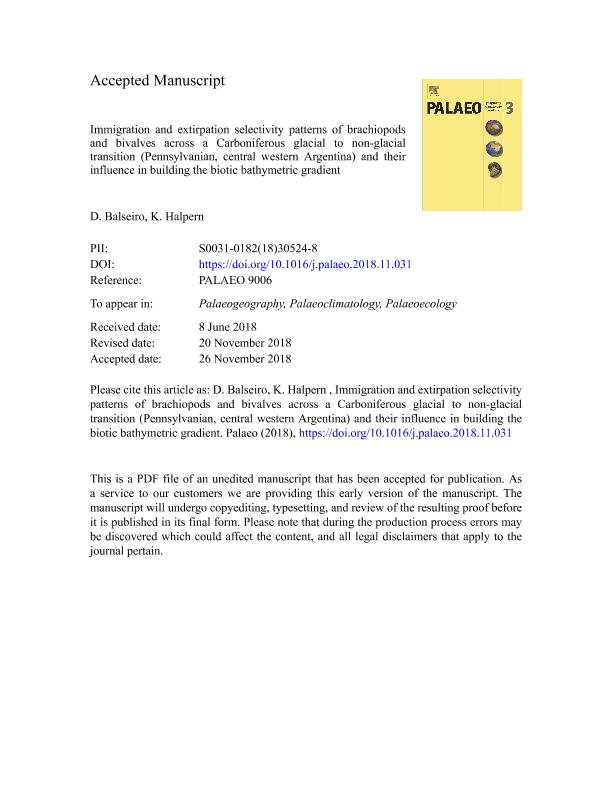Artículo
Immigration and extirpation selectivity patterns of brachiopods and bivalves across a Carboniferous glacial to non-glacial transition (Pennsylvanian, central western Argentina) and their influence in building the biotic bathymetric gradient
Fecha de publicación:
11/2018
Editorial:
Elsevier Science
Revista:
Palaeogeography, Palaeoclimatology, Palaeoecology
ISSN:
0031-0182
Idioma:
Inglés
Tipo de recurso:
Artículo publicado
Clasificación temática:
Resumen
The growth and demise of glaciers during the Late Paleozoic ice age had profound consequences on the marine biota. In central western Argentina the transition from glacial to non-glacial interval during the Pennsylvanian, caused a major regional turnover which remodeled the bathymetric diversity gradient. In order to understand the nature of the environmental changes related to such turnover event, we compared selectivity patterns in extirpation and immigration of bivalves and brachiopods using logistic regression. We tested for a wide range of potential drivers of extirpation and immigration, namely body size, geographic range size, environmental breadth, preferred depth, metabolic rates, infaunalism and taxonomic identity. While extirpation preferentially hit brachiopods and genera having smaller geographic ranges and smaller body sizes, immigration was related to genera with preference for deeper environment and small geographic ranges.Extirpation selectivity was not uniform along the bathymetric gradient. Both geographic range and body size selectivity are stronger towards deeper environments. Each clade, on the other hand, showed idiosyncratic responses to climate change. While brachiopods show extirpation selectivity for smaller geographic ranges, small sized bivalves were preferentially extirpated. These contrasting selectivity regimes, however, could be reflecting different faunal responses to the same environmental changing factor, namely higher thermal amplitude. Immigration in both brachiopods and bivalves was related to preference to deep environments, confirming previous results. However, brachiopods also showed preferential immigration of small geographic range genera, which is puzzling given the extinction selectivity related to the glacial non-glacial transition. Possible explanations point to a brief time span in which an increase in thermal amplitude occurred. The rapid climate changes, particularly related to a rise in maximum temperatures, lead the ecological response of the benthic faunas. Differences in extinction and immigration selectivity along the bathymetric gradient, suggest that the turnover event also remodeled the bathymetric gradient in body size and biogeographic structure and brachiopod:bivalve proportions. Such changes were driven by extirpation, contrasting with the remodeling of the bathymetric diversity gradient that was driven by immigration. Our results, therefore, highlight that immigration and extirpation can shape different aspects of the bathymetric biotic gradient.
Archivos asociados
Licencia
Identificadores
Colecciones
Articulos(CCT - MAR DEL PLATA)
Articulos de CTRO.CIENTIFICO TECNOL.CONICET - MAR DEL PLATA
Articulos de CTRO.CIENTIFICO TECNOL.CONICET - MAR DEL PLATA
Citación
Balseiro, Diego; Halpern, Karen; Immigration and extirpation selectivity patterns of brachiopods and bivalves across a Carboniferous glacial to non-glacial transition (Pennsylvanian, central western Argentina) and their influence in building the biotic bathymetric gradient; Elsevier Science; Palaeogeography, Palaeoclimatology, Palaeoecology; 516; 11-2018; 11-21
Compartir
Altmétricas




